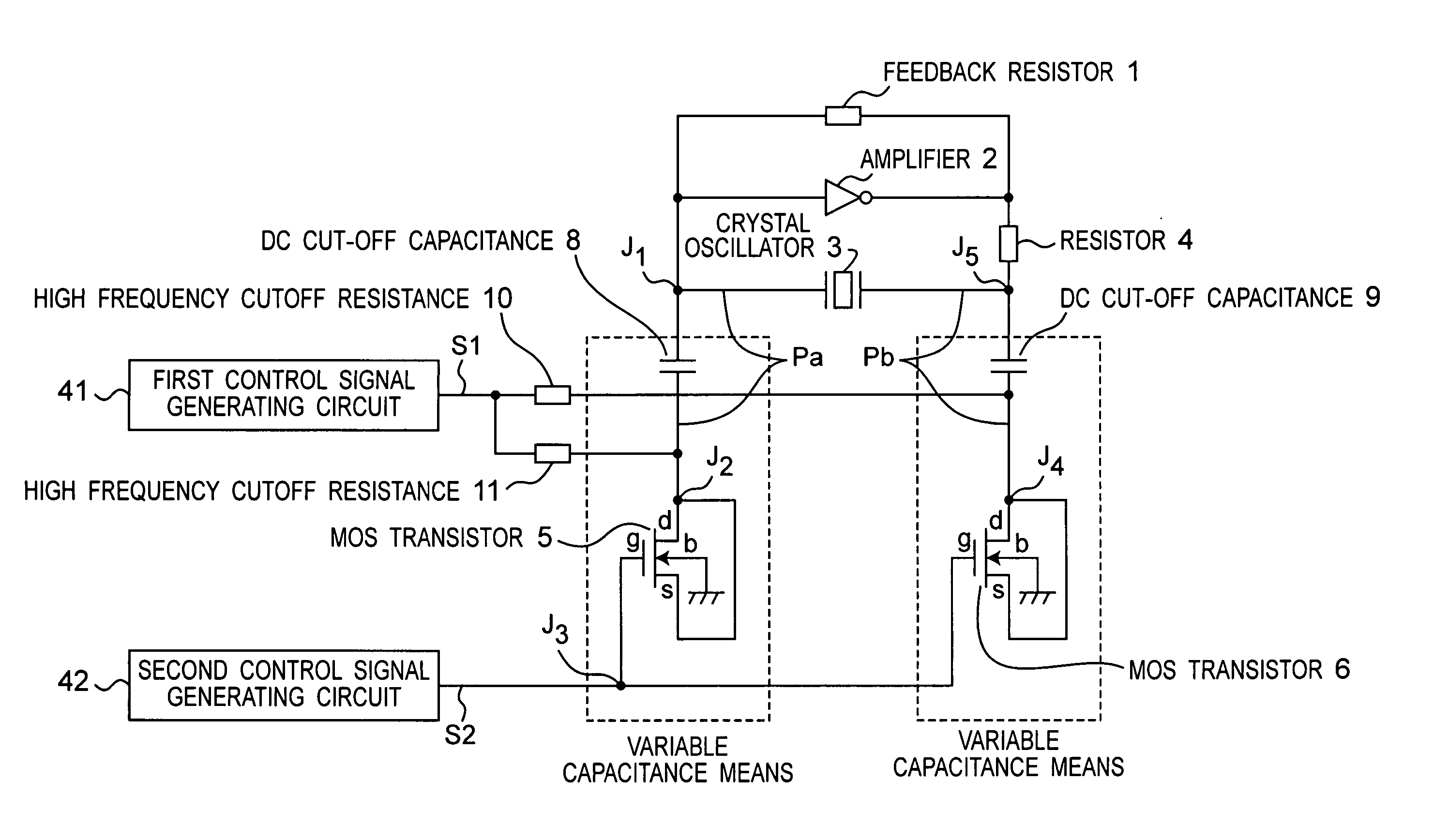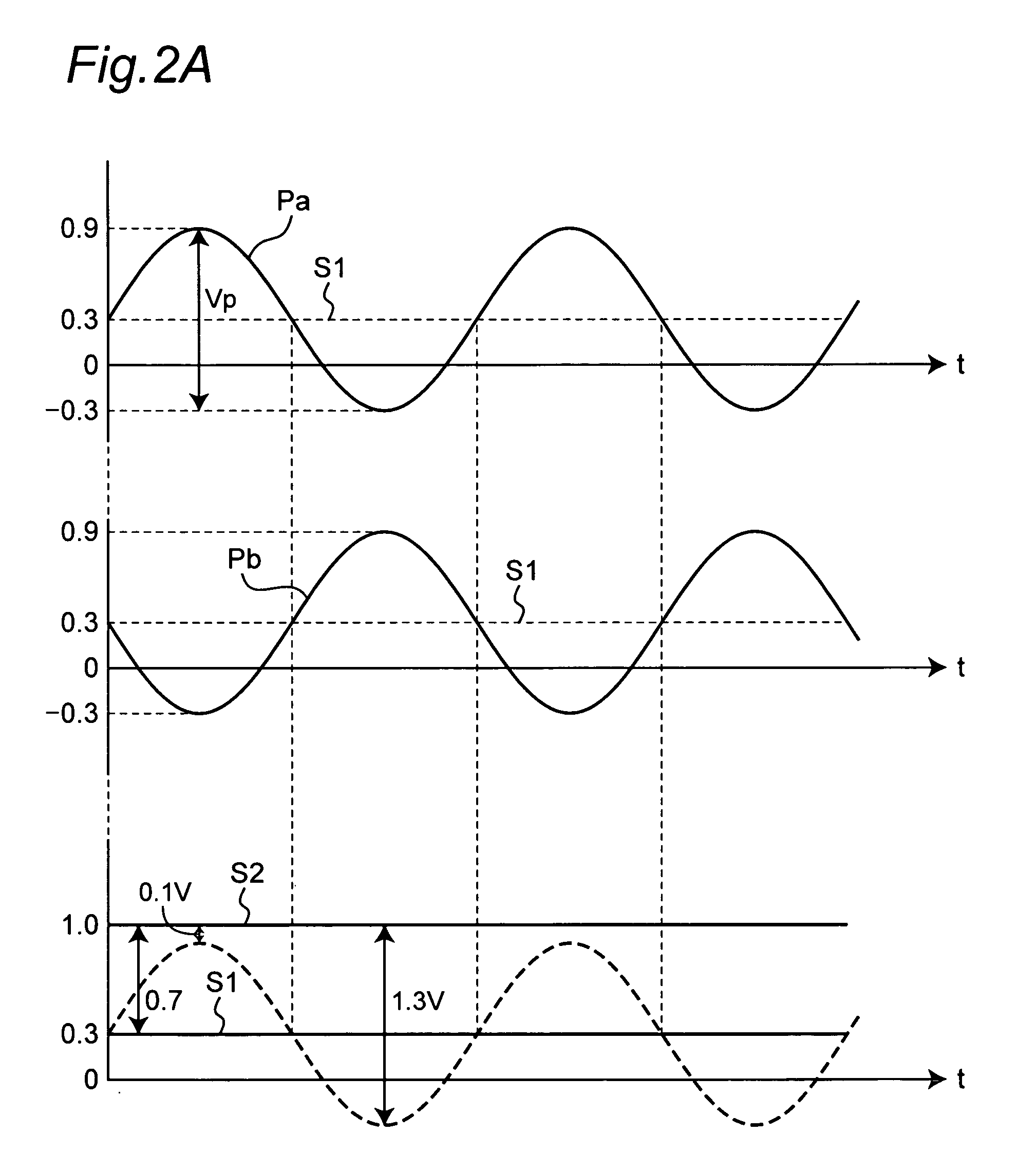Voltage controlled oscillator
a voltage control and oscillator technology, applied in the direction of oscillator, electrical equipment, etc., can solve the problems of inability to control the frequency around the desired gate voltage, the inability to set the capacitance switching voltage as desired, etc., and achieve the effect of simplifying the design
- Summary
- Abstract
- Description
- Claims
- Application Information
AI Technical Summary
Benefits of technology
Problems solved by technology
Method used
Image
Examples
embodiment 1
[0070]FIG. 1 is a circuit diagram showing the arrangement of a voltage controlled oscillator according to a first embodiment of the present invention. MOS transistors 5 and 6 are used as a variable capacitance in this first embodiment of the invention. Using MOS transistor 5 by way of example, the source s and drain d are shorted and the back gate b goes to ground. As described below, the capacitance between the source / drain and gate is variable. MOS transistor 5 is thus used as a variable capacitance device in the present invention. MOS transistor 6 is identical to MOS transistor 5.
[0071] As shown in FIG. 1, the oscillator circuit is composed of a feedback resistor 1 constituting a feedback circuit, an amplifier 2, and a crystal oscillator 3. The load capacitance of the oscillator circuit is the capacitance of the oscillation loop, which is the closed loop from one terminal of the crystal oscillator 3 to node J1, DC cut-off capacitance 8, node J2, MOS transistor 5, node J3, MOS tr...
embodiment 2
[0097]FIG. 5A is a schematic circuit diagram showing a voltage controlled oscillator according to a second embodiment of the present invention. As shown in FIG. 5A, the load capacitance of this oscillator circuit is the variable capacitance means composed of the first DC cut-off capacitance 8, variable capacitance MOS transistor 13, and a second DC cut-off capacitance 9 serial connected between the terminals of the crystal oscillator 3. The variable capacitance of this oscillator is the electrostatic capacitance produced between the source / drain and gate terminals of a MOS transistor 13 of which the source and drain are shorted. An arrangement in which an opposite phase oscillation voltage is applied to the source / drain and gate terminals is also possible.
[0098] A fourth control signal generating circuit 44 applies a fourth control signal S4 through high frequency cutoff resistance 14 to the source / drain terminal of MOS transistor 13. A fifth control signal generating circuit 45 ap...
embodiment 3
[0108]FIG. 9 is a schematic circuit diagram of a voltage controlled oscillator according to a third embodiment of the present invention. As shown in FIG. 9, this embodiment differs from the arrangement shown in FIG. 1 in that a variation cancellation circuit 20 is additionally disposed between the first control signal generating circuit 41 and high frequency cutoff resistance 10.
[0109] This variation cancellation circuit 20 is composed of MOS transistor 25, resistances 21, 22,26, 28, transistors 23, 24, and inversion amplifier 27. MOS transistor 25 is rendered near MOS transistors 5 and 6 and has the same IC structure and characteristics as MOS transistors 5 and 6. Voltage change due to temperature or variations in the MOS transistor 25 is inverted by the inversion amplifier 27 to a negative change. Voltage change due to temperature or variations in MOS transistors 5 and 6 appears as a positive at the drain and source of MOS transistors 5 and 6. These positive and negative changes ...
PUM
 Login to View More
Login to View More Abstract
Description
Claims
Application Information
 Login to View More
Login to View More - R&D
- Intellectual Property
- Life Sciences
- Materials
- Tech Scout
- Unparalleled Data Quality
- Higher Quality Content
- 60% Fewer Hallucinations
Browse by: Latest US Patents, China's latest patents, Technical Efficacy Thesaurus, Application Domain, Technology Topic, Popular Technical Reports.
© 2025 PatSnap. All rights reserved.Legal|Privacy policy|Modern Slavery Act Transparency Statement|Sitemap|About US| Contact US: help@patsnap.com



